Advertisement
A Beginner's Guide To Succulents + 13 Types That Experts Love

There is no one typical succulent, and plants that fall into this category come in tons of interesting colors, shapes, and patterns. Consider this your starter guide to 13 of the most spectacular succulents around and how to care for them, from expert green thumbs.
What makes a plant a succulent?
The term "succulent" refers to plants that store water in their leaves and/or stems. Most succulents are native to dry, sunny areas, so they need to hold on to water in case of a drought.
Debra Lee Baldwin, the author of Succulents Simplified, likens their plump leaves to a succulent steak. "When you push on it, it has that soft resilience," she tells mbg. "Tropical plants have thin leaves because they're getting plenty of moisture from either rain or humidity, so they don't need to store it."
How many types of succulents are there?
There are countless varieties of succulents growing wild around the world—and even more being bred in captivity.
"Based on the research I've found, there are over 10,000 different types of succulents that we know of, but a lot of those include the ones that humans are now cultivating and hybridizing," Rachael Cohen, the author of Infinite Succulent, tells mbg. Many wild species can only survive in a very particular habitat, but these cultivars are being bred to adapt to the average garden.
"Growers are constantly creating new hybrids with a variety of textures, cold hardiness levels, and colors," adds Cassidy Tuttle of Succulents and Sunshine.
13 key types to know.
There are plenty of succulents to choose from, but it's important to find one that stands a chance of surviving in your home or garden. Whether you're looking to liven up a small apartment or add some new textures to your extensive backyard, this list of 13 expert-approved succulents will have a type for you.
1. Aloe humilis 'hedgehog' (Hedgehog aloe)
James Monroe of Unknown Succulents appreciates the sharpness and boldness of all aloe varieties—beyond just the classic aloe vera. He loves that this interesting succulent type can change color depending on how much sunlight they get and grow to be as large as a car. "The majority of them are from South Africa, so when it comes to brightness, I don't suggest that people grow them indoors. They enjoy bright, bright light," he adds.
The Aloe humilis 'hedgehog' (Hedgehog aloe) is one funky variety that would look great on a porch or in the garden and give you plenty of cooling gel come summertime.
Bloomscape, Hedgehog Aloe ($35)
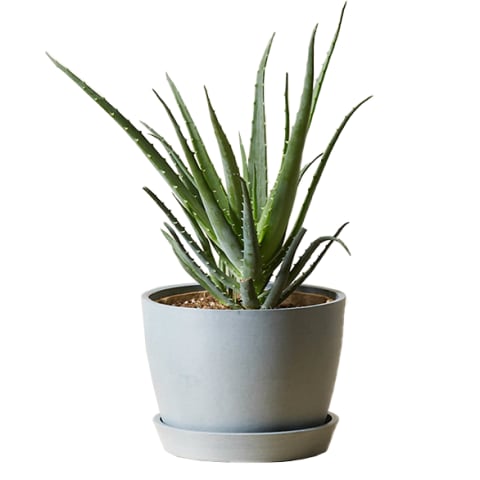
2. Echeveria Lola (Lola Succulent)
Echeverias are striking succulents to have around; their leaf pattern resembles a flower in bloom, and they come in a variety of desert shades. Most varieties, such as this Echeveria Lola, can also grow very quickly when given ample light.
Since Echeverias are basically works of art, Cohen loves turning them into jewelry. Simply secure a moss layer on top of a bracelet or headband, add your succulent, and you have a living design that should last a couple of weeks.
The Sill, Echeveria Lola ($32)
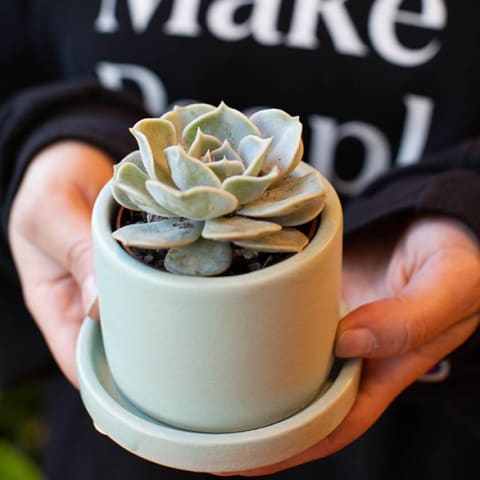
3. Beaucarnea recurvata (Ponytail palm)
Don't let its thin leaves fool you. The Beaucarnea recurvata (or Ponytail palm) is actually a succulent! Instead of storing water in its foliage, it keeps it in its bulbous trunk. Keep this plant in well-draining soil and bright light and it'll grow into a tall statement piece indoors or out.
Bloomscape, Ponytail Palm ($55)
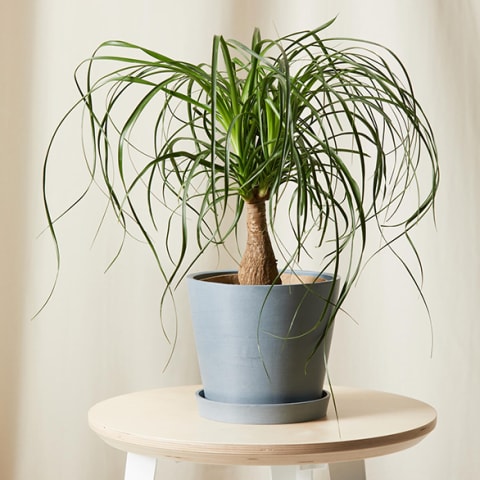
4. Sansevieria (Snake Plant)
Yes, the popular Sansevieria (also called Snake Plant and Mother In Law's Tongue) collects water in its long leaves and is, therefore, a succulent. As most Snake Plant parents can attest, these plants are very easy to grow indoors and can go weeks without watering.
"Architects and designers love Sansavierias because of their crisp, upright, swordlike geometry," adds Baldwin. The plant can also grow to be the size of a tall human, making it quite the statement piece.
Bloomscape, Sansevieria ($149)
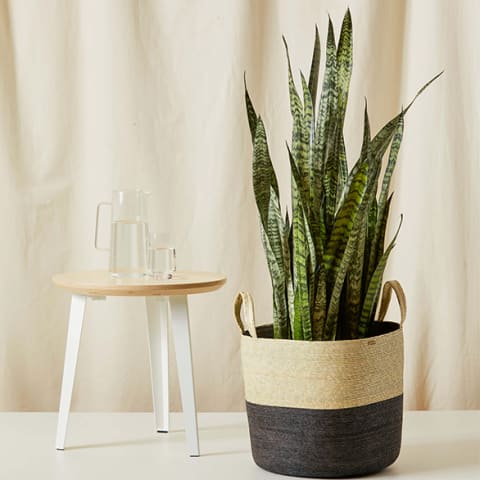
5. Haworthia fasciata (Zebra Plant)
Multiple experts pointed to Haworthias as some of the easiest succulents to care for indoors, and Monroe notes that this genus tends to be more forgiving of overwatering than other succulents.
The fun printed leaves on this particular Haworthia, the Zebra Plant, should thrive on any sunny windowsill. "It can be found in a lot of home improvement stores, and it's sometimes seen at grocery stores, so it's a highly accessible plant," he adds.
The Succulents Box, Haworthia Zebra Plant ($5.75)
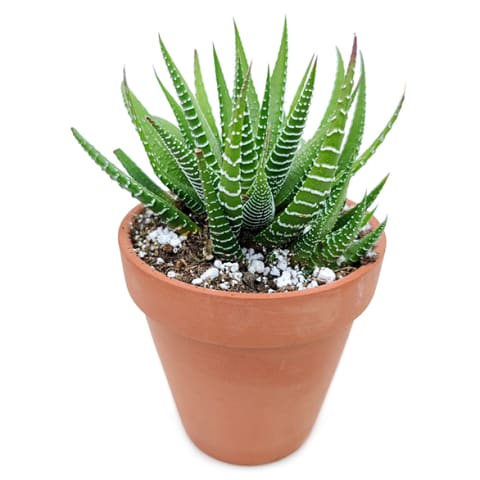
6. Crassula ovata (Jade Plant)
Jade plants tend to be very hardy, and Cohen notes that it's not uncommon to see one that has been passed down through generations. "There's this legacy that Jade has that's so beautiful. It's such a nice energy to bring into your home space," she says. Tuttle adds that most varieties of this classic green succulent can grow well indoors as houseplants and are pretty forgiving about watering. Just be sure to give it enough sun. The Sunset Jade pictured has reverted to green, but this variety can take on beautiful hues of red and yellow.
Amazon, Sunset Jade Plant ($12.50)
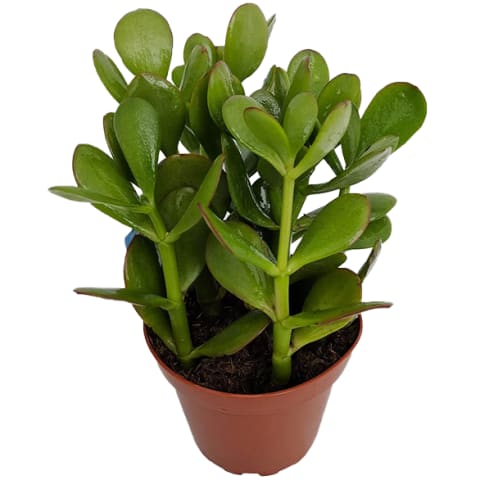
7. Lithops (Living Stone)
With a name that conjures visions of Jurassic Park, Lithops are ancient plants that were first discovered hundreds of years ago. Their nickname is "Living Stone" because they grow in clusters very close to the ground. "It's a plant that is 98% leaf," says Monroe, which tells you something about its care needs. "It does not need to be watered that often, which is where beginners can go wrong," he adds.
Give yours plenty of time between waterings to ensure that its leaves don't become too full and burst. Plant your Lithops in gritty, rocky soil to further help out with drainage.
Micro Landscape Design, Live Exotic Lithops Plant ($22.99)
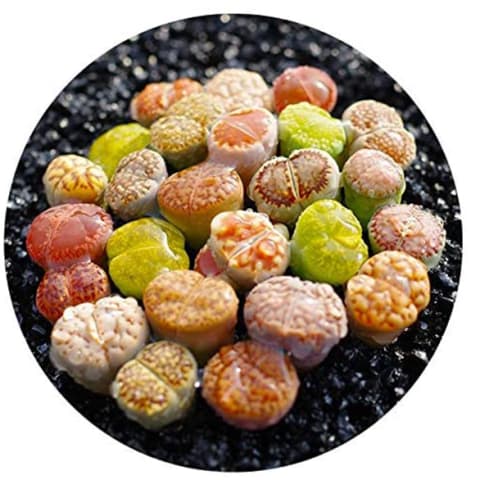
8. Kalanchoe Thyrsiflora (Paddle Plant)
As the nickname suggests, this succulent has paddle-shaped leaves that sit on top of each other in unique layers. It's also sometimes called Red Lips because the edges of its leaves can take on a striking red hue in the sun. It would do well in a sunny garden that stays warm throughout the year.
Succulent Market, Kalanchoe Thyrsiflora ($8.99)
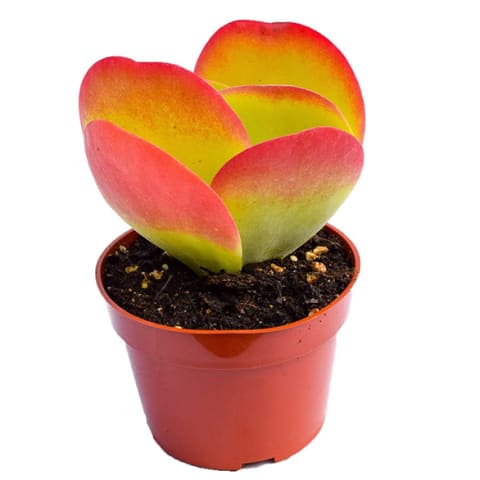
9. Graptoveria 'Fred Ives'
A personal favorite of Tuttle's, this succulent "has a really pretty purple/pink coloring and propagates easily," she says. "You can grow new babies from cuttings and leaves, plus it will put off many new babies on its own." This is another plant that can survive indoors, and you should definitely bring yours inside for the winter if you live in a colder climate.
Succulents Box, Graptoveria Fred Ives ($6.35)
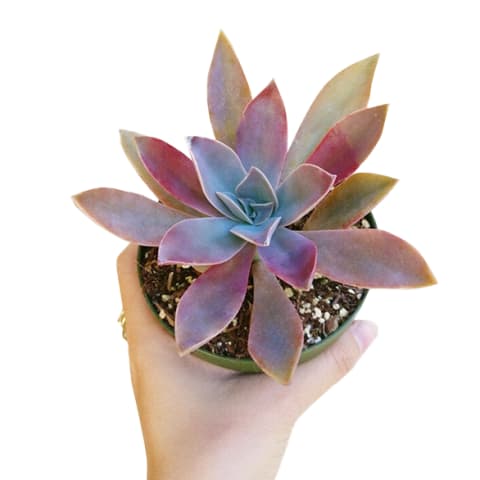
10. Senecio rowleyanus (String of Pearls)
The leaves on this cascading plant resemble a delicate string of pearls and make for a lovely accent in an open terrarium or indoor arrangement. They can also grow pretty quickly—especially when treated to a little fertilizer in spring and summer.
Amazon, String of Pearls ($34.99)
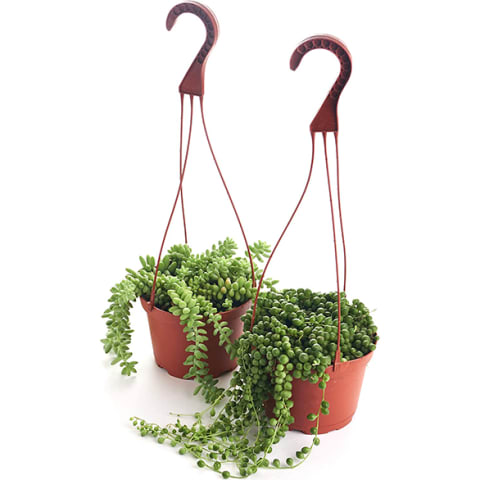
11. Gasteria Liliputana (Dwarf Ox-Tongue)
Monroe appreciates that this speckled succulent is very slow-growing, making it another nice pick for a terrarium or another small space. While it might be hard to spot any growth with the naked eye, he says that taking pictures of your Gasteria every few months can help you pick up on its subtle progress.
Etsy, Gasteria Liliputana ($8.99)

12. Sedum pachyphyllum 'Salsa' (Jelly Beans)
Sedums are perennial plants that have a delicate-looking string of succulent leaves. They come in a few varieties, and Cohen likes to use them as ground cover in her garden. Different types come in unique colors, like this loud Sedum 'Salsa' that's light green and watermelon-red.
Etsy, Sedum Salsa ($45)
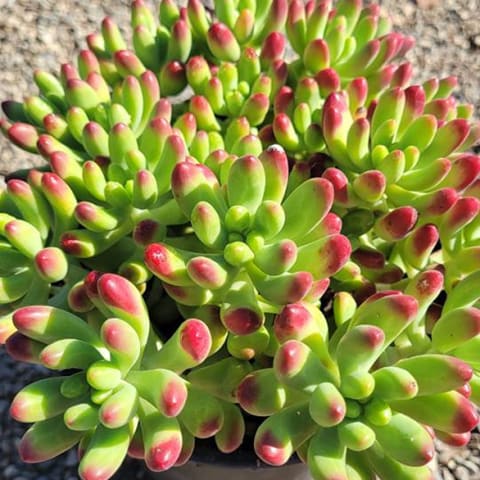
13. Aeonium 'Fiesta'
Aeonium succulents make for dramatic garden plants since they usually bloom a beautiful flower before dying. Cohen notes that pollinators love this final display, and it's a feast for the eyes too. "What's interesting is that before they put up this "death bloom," they usually propagate and create all these little pups around their base," she notes, making this succulent a beautiful symbol for the cycle of life.
Etsy, Aeonium 'Fiesta' ($8)
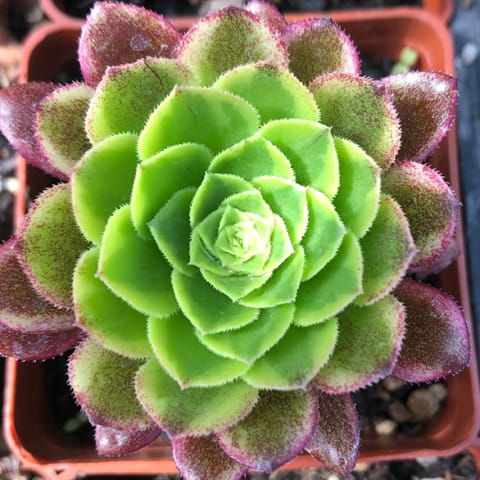
Tips & tricks.
Once you've tracked down your succulent of choice, these pro tips will help you care for it:
- Don't water your succulents too much: Since most succulents have evolved in dry areas, you don't want to give them too much water. "If you water too much, the leaves will get too plump and split open, or the bottom leaves will start to darken and that's root rot," Monroe explains. He typically starts by watering a new succulent once a month and then adjusts his care routine from there. Baldwin notes that typically, the thicker a succulent's leaves, the more moisture it can store between waterings.
- But don't let them totally dry out either: While you shouldn't give your succulent too much water, you shouldn't totally deprive it either. If you see its leaves begin to shrivel up and droop, this is a sign your plant could use a drink, says Monroe. "If you see a super plump succulent, it's going to be full of water. If you don't water it for an extended amount of time, you'll start to see it wrinkle because it doesn't have tissue inside with that extra moisture," he adds.
- Be careful when watering your succulents: Some succulents have prickly spikes that you don't want to touch. Be careful when watering these and keep them out of reach of curious pets or children.
- Give it plenty of light: Baldwin notes that succulents are similar to people on vacation in that "they like sunshine and warm breezes and they love to sunbathe." As such, they can be a challenge to grow indoors where the sun isn't always shining. If you are keeping a succulent inside your home, be sure to put it near a window that gets plenty of light.
- Watch out for color changes: Succulents can also get burned when exposed to too much sun (the vacation analogy continues!). Baldwin notes that some succulents release a color pigment to protect themselves from the sun, which acts as a natural umbrella. If you see your plant's leaves suddenly turning red, orange, blue, or purple, try moving it to a slightly shadier spot.
- Propagate as you wish: Most succulents are master propagators, and their leaves can be cut off and easily replanted into a new container with fresh soil. Typically, the area that you cut off will grow back within a few weeks. Tuttle adds that some succulents—including Echeveria, Kalanchoe, and Sedum varieties—don't even need to be placed in soil. Instead, she explains, "you can gently remove a leaf from the succulent, set it out on a dry surface for a couple of days, then place it on damp soil for the next few weeks. A new baby will start growing on the leaf. As you continue to water it, it will grow into a full plant!" Cohen adds that this is an especially fun thing to do with kids, who will be amazed by succulents' ability to regenerate (chances are, you will be too!).
- Do your research: Be sure to read up on any new-to-you succulents before you bring them into your space. While they all share some similarities, each type has particular care needs of its own. Baldwin suggests treating it like you would a new pet. "You would never buy a puppy without finding out every last detail about it," after all.
The bottom line.
Whether you're looking for a gift for yourself or the plant lover in your life, these 13 types of succulents can add a pop of color and fun to any greenery collection. Show them some love by learning about their unique care needs and going easy on the watering and heavy on the sunlight.
Watch Next
Enjoy some of our favorite clips from classes
Enjoy some of our favorite clips from classes
What Is Meditation?
Mindfulness/Spirituality | Light Watkins
Box Breathing
Mindfulness/Spirituality | Gwen Dittmar
What Breathwork Can Address
Mindfulness/Spirituality | Gwen Dittmar
The 8 Limbs of Yoga - What is Asana?
Yoga | Caley Alyssa
Two Standing Postures to Open Up Tight Hips
Yoga | Caley Alyssa
How Plants Can Optimize Athletic Performance
Nutrition | Rich Roll
What to Eat Before a Workout
Nutrition | Rich Roll
How Ayurveda Helps Us Navigate Modern Life
Nutrition | Sahara Rose
Messages About Love & Relationships
Love & Relationships | Esther Perel
Love Languages
Love & Relationships | Esther Perel


















